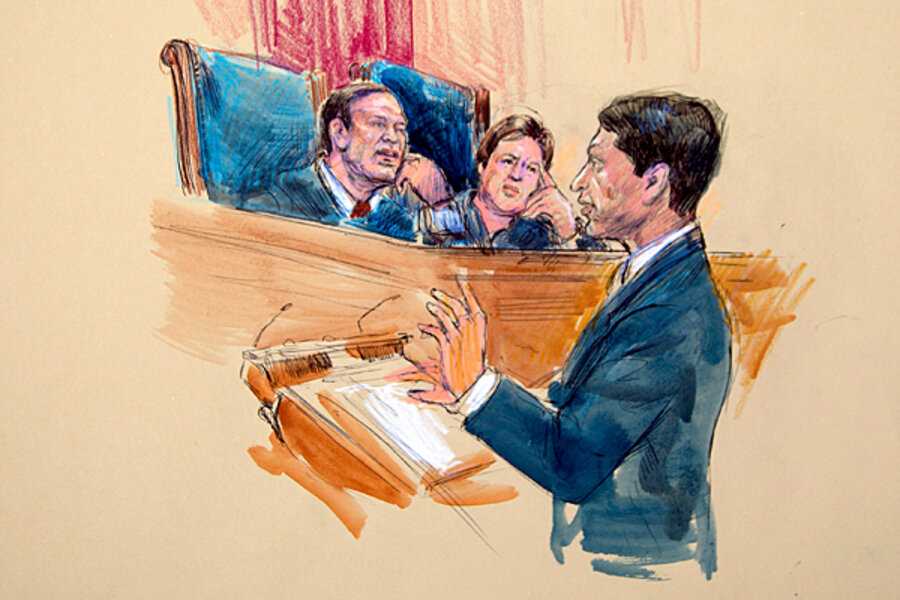With three nominations to D.C. Circuit court, Obama gets aggressive
| Washington
President Obama is set to unveil three nominations Tuesday morning to a top federal appeals court, an aggressive move to fill seats that have long gone vacant amid partisan wrangling.
If confirmed by the Senate, the three selections would bring the US Court of Appeals for the District of Columbia Circuit to 11 judges – a rare moment of full capacity – and address what the Obama administration sees as the court’s conservative tilt. But more likely, the nominees will spark intense Republican opposition and could hasten a showdown over Senate filibusters.
According to published reports, the three nominees are Cornelia “Nina” Pillard, a law professor at Georgetown University in Washington, D.C.; Patricia Millett, an appellate lawyer; and Robert Wilkins, a federal district judge. The announcement is scheduled for 10:30 a.m. Eastern time.
“They’re all very strong,” says Carl Tobias, a law professor at the University of Richmond in Virginia. “There's no real basis to oppose them on the merits. But we’ll see all kinds of arguments that the court doesn’t need more judges…. I think there’s a battle royale coming.”
The D.C. Circuit is widely seen as the second most important court in the nation, after the US Supreme Court. Its cases are often national in scope, involving federal regulations and agencies, as well as national security. Because the Supreme Courts takes so few lower court cases, the D.C. Circuit is typically the last word on important matters. And it is a training ground for the Supreme Court: Four of the nine current justices, including Chief Justice John Roberts, served there.
During his presidency, Mr. Obama has won some victories in the D.C. Circuit, but he has also seen parts of his agenda overturned – on the environment, on tobacco, on Wall Street regulation. In January, the court ruled unconstitutional Obama’s three recess appointments to the National Labor Relations Board last year.
It’s true that the Senate recently voted unanimously to confirm Sri Srinivasan to the D.C. Circuit, making him the first judge to join that court since 2006. But Senate Republicans have made clear that that was a one-off event – and that they believe the D.C. Circuit now has all the judges it needs to handle its case load. In April, Sen. Charles Grassley of Iowa, the top Republican on the Senate Judiciary Committee, introduced legislation to add a seat to both the Second and 11th Circuit Courts, and to remove three seats from the D.C. Circuit.
Senator Grassley says the shift of seats away from the D.C. Circuit is necessary to “ease the pressure on the heavy workloads” of the two other courts. But some legal experts say a numerical comparison of the courts’ respective caseloads does not factor in the complexity and scope of the cases that reach the D.C. Circuit.
Grassley and other top Republicans have referred to Obama’s plan to fill the vacancies on the D.C. Circuit as “court packing,” like President Franklin Roosevelt’s ill-fated push in the 1930s to adds seats to the Supreme Court to obtain faovrable rulings. Democrats reject the analogy, and flip it on its head, calling Grassley’s move “court unpacking.” Senior White House adviser Dan Pfeiffer calls the idea “a blatant attempt to shrink President Obama’s constitutional authority to fill this court.”
The D.C. Circuit has been working at less-than-full strength for years, and now, with Judge Srinivasan’s confirmation, the court has four Democratic nominees and four Republican nominees, plus the three vacancies. But there are also six “senior” (semiretired) judges who hear cases, five of whom are Republican picks, leading Democrats to say the court has a conservative cast.
“It’s sort of a lodestone of the hard right to make sure they control the D.C. Circuit,” says Sen. Charles Schumer (D) of New York, a member of the Judiciary Committee.
Grassley rejects this argument, saying that “political questions are appropriately left to the legislative branch of government.”
The 97-to-0 Senate vote on May 23 to confirm Srinivasan stood in stark contrast to the challenges Obama has faced with other nominees. Analysts say Srinivasan, the first South Asian to serve on a federal appellate court, enjoyed broad, bipartisan support in the legal community. He clerked for Supreme Court Justice Sandra Day O’Connor (a Republican nominee), served in the solicitor general’s office of both the Bush and Obama administrations, and has not been involved in politics.
Another Obama pick for the D.C. Circuit, Caitlin Halligan, was filibustered in the Senate multiple times and ultimately withdrew. Republicans cited her pro-gun-control stance while solicitor general for the state of New York.
One big question hanging over the newest D.C. Circuit nominations – as well as other high-level Obama administration nominees facing confirmation challenges – is whether Senate majority leader Harry Reid will follow through on his threat to change the rules on filibusters, a delaying tactic. The Nevada Democrat is reportedly considering eliminating the 60-vote requirement to overcome filibusters on all judicial and executive branch nominations – a move dubbed the “nuclear option.”
Democrats currently control the Senate, 54 to 45, so without the 60-vote threshold they would have an easier time approving presidential nominees. Two of Obama’s cabinet-level appointments – Defense Secretary Chuck Hagel and CIA Director John Brennan – have faced filibusters this year. Others appear headed for trouble.
The downside for Democrats in going “nuclear” is that the next time there’s a Republican president and a Republican-majority Senate, Democrats will have a hard time blocking nominees they find objectionable. But Democrats who support going nuclear are willing to live with that. Elections have consequences, they say.









